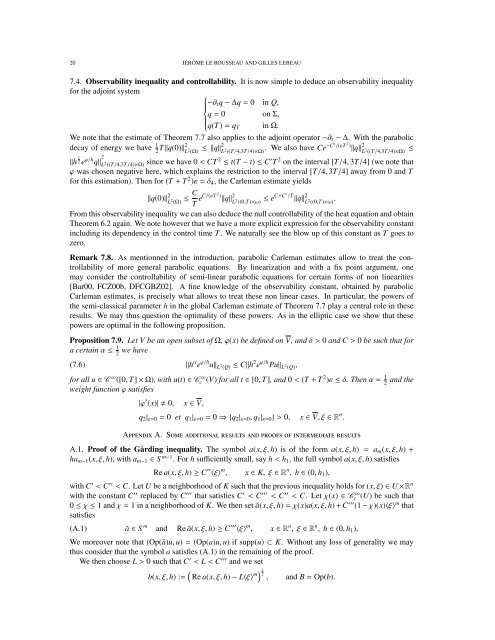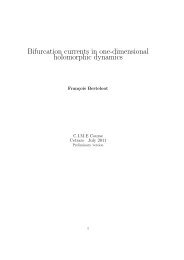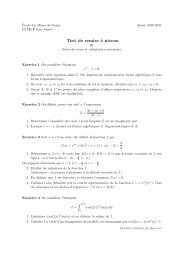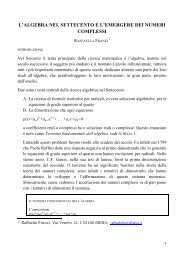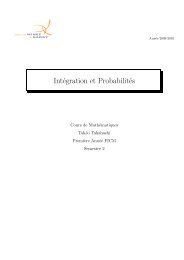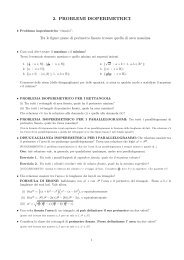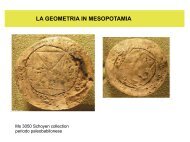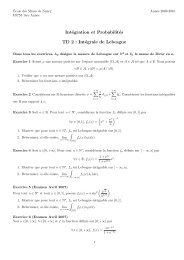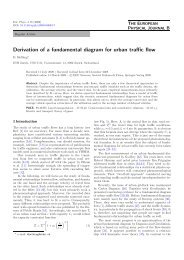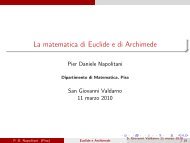on carleman estimates for elliptic and parabolic operators ...
on carleman estimates for elliptic and parabolic operators ...
on carleman estimates for elliptic and parabolic operators ...
You also want an ePaper? Increase the reach of your titles
YUMPU automatically turns print PDFs into web optimized ePapers that Google loves.
20 JÉRÔME LE ROUSSEAU AND GILLES LEBEAU<br />
7.4. Observability inequality <strong>and</strong> c<strong>on</strong>trollability. It is now simple to deduce an observability inequality<br />
<strong>for</strong> the adjoint system<br />
⎧<br />
−∂ t q − ∆q = 0 in Q,<br />
⎪⎨<br />
q = 0 <strong>on</strong> Σ,<br />
⎪⎩ q(T) = q T in Ω.<br />
We note that the estimate of Theorem 7.7 also applies to the adjoint operator −∂ t − ∆. With the <strong>parabolic</strong><br />
decay of energy we have 1 2 T‖q(0)‖2 L 2 (Ω)<br />
≤ ‖q‖ 2 L 2 ((T/4,3T/4)×Ω) . We also have Ce−C′ /(εT 2) ‖q‖ 2 L 2 ((T/4,3T/4)×Ω)<br />
≤<br />
‖h 1 2 e ϕ/h q‖ 2 L 2 ((T/4,3T/4)×Ω) since we have 0 < CT 2 ≤ t(T − t) ≤ C ′ T 2 <strong>on</strong> the interval [T/4, 3T/4] (we note that<br />
ϕ was chosen negative here, which explains the restricti<strong>on</strong> to the interval [T/4, 3T/4] away from 0 <strong>and</strong> T<br />
<strong>for</strong> this estimati<strong>on</strong>). Then <strong>for</strong> (T + T 2 )ε = δ 4 , the Carleman estimate yields<br />
‖q(0)‖ 2 L 2 (Ω) ≤ C T eC/(εT 2) ‖q‖ 2 L 2 ((0,T)×ω) ≤ eC+C′ /T ‖q‖ 2 L 2 ((0,T)×ω) .<br />
From this observability inequality we can also deduce the null c<strong>on</strong>trollability of the heat equati<strong>on</strong> <strong>and</strong> obtain<br />
Theorem 6.2 again. We note however that we have a more explicit expressi<strong>on</strong> <strong>for</strong> the observability c<strong>on</strong>stant<br />
including its dependency in the c<strong>on</strong>trol time T. We naturally see the blow up of this c<strong>on</strong>stant as T goes to<br />
zero.<br />
Remark 7.8. As menti<strong>on</strong>ned in the introducti<strong>on</strong>, <strong>parabolic</strong> Carleman <strong>estimates</strong> allow to treat the c<strong>on</strong>trollability<br />
of more general <strong>parabolic</strong> equati<strong>on</strong>s. By linearizati<strong>on</strong> <strong>and</strong> with a fix point argument, <strong>on</strong>e<br />
may c<strong>on</strong>sider the c<strong>on</strong>trollability of semi-linear <strong>parabolic</strong> equati<strong>on</strong>s <strong>for</strong> certain <strong>for</strong>ms of n<strong>on</strong> linearities<br />
[Bar00, FCZ00b, DFCGBZ02]. A fine knowledge of the observability c<strong>on</strong>stant, obtained by <strong>parabolic</strong><br />
Carleman <strong>estimates</strong>, is precisely what allows to treat these n<strong>on</strong> linear cases. In particular, the powers of<br />
the semi-classical parameter h in the global Carleman estimate of Theorem 7.7 play a central role in these<br />
results. We may thus questi<strong>on</strong> the optimality of these powers. As in the <strong>elliptic</strong> case we show that these<br />
powers are optimal in the following propositi<strong>on</strong>.<br />
Propositi<strong>on</strong> 7.9. Let V be an open subset of Ω, ϕ(x) be defined <strong>on</strong> V, <strong>and</strong> δ > 0 <strong>and</strong> C > 0 be such that <strong>for</strong><br />
a certain α ≤ 1 2<br />
we have<br />
‖h<br />
(7.6)<br />
α e ϕ/h u‖ L 2 (Q) ≤ C‖h 2 e ϕ/h Pu‖ L 2 (Q),<br />
<strong>for</strong> all u ∈ C ∞ ([0, T] × Ω), with u(t) ∈ Cc ∞ (V) <strong>for</strong> all t ∈ [0, T], <strong>and</strong> 0 < (T + T 2 )ε ≤ δ. Then α = 1 2<br />
<strong>and</strong> the<br />
weight functi<strong>on</strong> ϕ satisfies<br />
|ϕ ′ (x)| 0, x ∈ V,<br />
q 2 | ε=0 = 0 et q 1 | ε=0 = 0 ⇒ {q 2 | ε=0 , q 1 | ε=0 } > 0, x ∈ V, ξ ∈ R n .<br />
APPENDIX A. SOME ADDITIONAL RESULTS AND PROOFS OF INTERMEDIATE RESULTS<br />
A.1. Proof of the Gårding inequality. The symbol a(x, ξ, h) is of the <strong>for</strong>m a(x, ξ, h) = a m (x, ξ, h) +<br />
ha m−1 (x, ξ, h), with a m−1 ∈ S m−1 . For h sufficiently small, say h < h 1 , the full symbol a(x, ξ, h) satisfies<br />
Re a(x, ξ, h) ≥ C ′′ 〈ξ〉 m , x ∈ K, ξ ∈ R n , h ∈ (0, h 1 ),<br />
with C ′ < C ′′ < C. Let U be a neighborhood of K such that the previous inequality holds <strong>for</strong> (x, ξ) ∈ U ×R n<br />
with the c<strong>on</strong>stant C ′′ replaced by C ′′′ that satisfies C ′ < C ′′′ < C ′′ < C. Let χ(x) ∈ Cc ∞ (U) be such that<br />
0 ≤ χ ≤ 1 <strong>and</strong> χ = 1 in a neighborhood of K. We then set ã(x, ξ, h) = χ(x)a(x, ξ, h) + C ′′′ (1 − χ)(x)〈ξ〉 m that<br />
satisfies<br />
(A.1)<br />
ã ∈ S m <strong>and</strong> Re ã(x, ξ, h) ≥ C ′′′ 〈ξ〉 m , x ∈ R n , ξ ∈ R n , h ∈ (0, h 1 ),<br />
We moreover note that (Op(ã)u, u) = (Op(a)u, u) if supp(u) ⊂ K. Without any loss of generality we may<br />
thus c<strong>on</strong>sider that the symbol a satisfies (A.1) in the remaining of the proof.<br />
We then choose L > 0 such that C ′ < L < C ′′′ <strong>and</strong> we set<br />
b(x, ξ, h) := ( Re a(x, ξ, h) − L〈ξ〉 m) 1 2<br />
,<br />
<strong>and</strong> B = Op(b).


